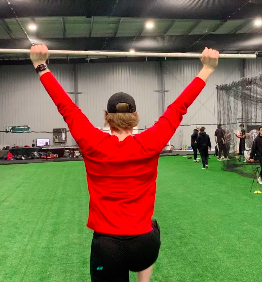Framework For Training Youth Athletes

In today’s post, I’m going to outline a few principles that make up the framework I utilize to train youth athletes, in the early stages of the training process.
For the sake of today’s post I’m going to define ‘youth athletes’ as 14-17 years old. It’s important to remember that training age trumps biological age. With that in mind, you can apply these principles to any novice/early-intermediate trainee.
- Learn To Move Well! Develop A Strong Foundation In The Five Basic Movements:
Gray Cook said it best, “First move well. Then move often.”
We want to build foundational capacity in how the athlete moves and their awareness of how they move. We want to gradually increase load, but this needs to be earned through excellent technique. We don’t want to pile strength on top of dysfunction.
What are the five fundamental movements?
Squat. Hinge. Lunge. Push. Pull.
2. Walk Before You Run. Develop Your Progression/Regression Continuums
Load cannot be the only way we progress. As the athlete continues to develop proficiency, we must increase the technical demand as well.
I have found it extremely valuable to have progressions and regressions for each of the patterns. This makes both writing programs much more efficient, and allows for you to have a solid ‘plan B’ and quickly adapt on the floor to either increase or decrease the challenge for the athlete in front of you.
As an example, here’s my Lunge P/R Continuum:
TRX Assisted Split Squat -> Step Ups ->Goblet Split Squat -> Goblet Reverse Lunge -> Db 1-Arm Reverse Lunge -> Db Lunge Walk -> Db Reverse Lunge from Deficit -> Goblet Bulgarian Split Squats -> Barbell Loaded Reverse Lunges
Once they reach barbell lunges, they’re pretty advanced. Your mileage may vary a little on this list, especially with goblet vs. db in each hand variations, but this is what I use currently.
3. Prioritize Strength!
Every parent of every 14 year old that I meet with tells me their kid needs to get faster.
The reality is, we need to prioritize building strength first in order to meet our long-term goals. Strength is the foundation of power. You can’t shoot a cannon out of a canoe!
4. Master the Basic Core Movements!
For me these are: prone plank, side plank, deadbug, birddog, and pallof press.
From there, just like the lunge example I gave, you can increase the challenge as they earn the right to do so.
5. Learn to Brace, Then Learn ‘To Brace Behind The Shield’
At first, we need to teach athletes to create as much tension as possible. On their pallofs I want them squeezing everything as hard as they can! This is an important quality to develop.
The next step is learning how to create this kind of tension while simultaneously staying relaxed. This is crucial to athletic performance because we want loose, explosive, ‘effortless‘ movement.
6. Develop Brakes!
We need to develop an ability to absorb force, specifically ground reaction force. Again, walk before you run.
Think landing softly on a broad jump or box jump. Same thing in the frontal plane and with unilateral variations before trying to program repeated plyometric jumps.
7. Dabble With “The Sixth Movement”
I believe it was Dan John who coined this term. The ‘sixth movement’ would be: carries, medicine ball throws, bear crawls, etc.
8. Own The Sagittal Plane.
We need to own the squat, deadlift, and lunge before moving into the frontal and transverse planes.
9. Make It Fun!
It’s so important to help these young athletes fall in love with the training process in order to get buy-in and to get long-term adherence. Help them to succeed, connect with the person in front of you, and create an environment that blends hard work with fun.
